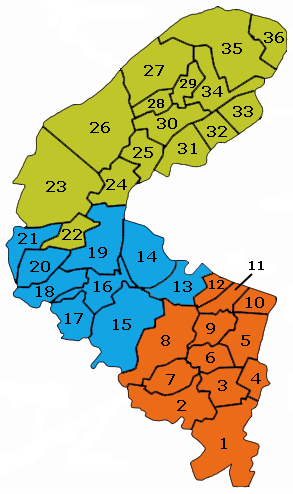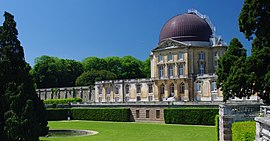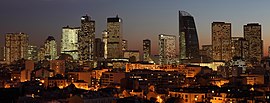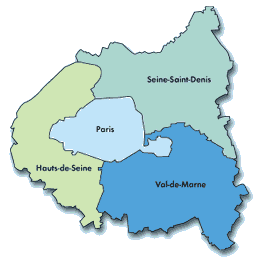Hauts-de-Seine | |
|---|---|
From top down, left to right: a view of Boulogne-Billancourt from the Parc de Saint-Cloud, Meudon site of the Paris Observatory, the Château de Sceaux, lake in Rueil-Malmaison, La Défense seen from La Garenne-Colombes | |
 Location of Hauts-de-Seine in France | |
| Coordinates: 48°50′N 02°12′E / 48.833°N 2.200°E | |
| Country | France |
| Region | Île-de-France |
| Prefecture | Nanterre |
| Subprefectures | Antony Boulogne- Billancourt |
| Government | |
| • President of the Departmental Council | Georges Siffredi[1] (LR) |
| Area | |
• Total | 176 km2 (68 sq mi) |
| Population (2021)[2] | |
• Total | 1,635,291 |
| • Rank | 5th |
| • Density | 9,300/km2 (24,000/sq mi) |
| Demonym | Altoséquanais.e |
| GDP | |
| • Total | €188.333 billion (2021) |
| • Per capita | €115,168 (2021) |
| Time zone | UTC+1 (CET) |
| • Summer (DST) | UTC+2 (CEST) |
| ISO 3166 code | FR-92 |
| Department number | 92 |
| Arrondissements | 3 |
| Cantons | 23 |
| Communes | 36 |
| ^1 French Land Register data, which exclude estuaries and lakes, ponds and glaciers larger than 1 km2 | |
Hauts-de-Seine (French pronunciation: [o d(ə) sɛn] ; lit. 'Seine Heights') is a department in the Île-de-France region of France. It covers Paris's western inner suburbs. It is bordered by Paris, Seine-Saint-Denis and Val-de-Marne to the east, Val-d'Oise to the north, Yvelines to the west and Essonne to the south. With a population of 1,624,357 (as of 2019)[4] and a total area of 176 square kilometres (68 square miles), it has the second highest population density among all departments of France, after Paris. It is the fifth most populous department in France. Its prefecture is Nanterre, but Boulogne-Billancourt, one of its two subprefectures, alongside Antony, has a larger population.
Hauts-de-Seine is best known for containing the modern office, cinema and shopping complex La Défense, one of Grand Paris's main economic centres and one of Europe's major business districts. Hauts-de-Seine is one of the wealthiest departments in France; it had the highest GDP per capita in France at €107,800 in 2020.[5] Its inhabitants are called Altoséquanais (masculine) and Altoséquanaises (feminine) in French.
History
[edit]From 1790 to 1968, Hauts-de-Seine was part of the former department of Seine.
The Hauts-de-Seine department was created in 1968, from parts of the former departments of Seine and Seine-et-Oise. Its creation reflected the implementation of a law passed in 1964; Nanterre had already been selected as the prefecture for the new department early in 1965.
In 2016, the Departmental Council of Hauts-de-Seine voted in favour of a fusion of Hauts-de-Seine and Yvelines, its western neighbour. Following a similar vote in Yvelines, an établissement public interdépartemental was established.[6] The fusion project was abandoned in 2021, but the cooperation between the two departments continues.[7]
Demographics
[edit]Population development since 1881
[edit]
|
| ||||||||||||||||||||||||||||||||||||||||||||||||||||||||||||
| |||||||||||||||||||||||||||||||||||||||||||||||||||||||||||||
| Sources:[8][9] | |||||||||||||||||||||||||||||||||||||||||||||||||||||||||||||
Place of birth of residents
[edit]| Born in metropolitan France | Born outside metropolitan France | |||
|---|---|---|---|---|
| 80.6% | 19.4% | |||
| Born in overseas France |
Born in foreign countries with French citizenship at birth1 | EU-15 immigrants2 | Non-EU-15 immigrants | |
| 1.5% | 3.5% | 3.8% | 10.6% | |
| 1 This group is made up largely of former French settlers, such as pieds-noirs in Northwest Africa, followed by former colonial citizens who had French citizenship at birth (such as was often the case for the native elite in French colonies), as well as to a lesser extent foreign-born children of French expatriates. A foreign country is understood as a country not part of France in 1999, so a person born for example in 1950 in Algeria, when Algeria was an integral part of France, is nonetheless listed as a person born in a foreign country in French statistics. 2 An immigrant is a person born in a foreign country not having French citizenship at birth. An immigrant may have acquired French citizenship since moving to France, but is still considered an immigrant in French statistics. On the other hand, persons born in France with foreign citizenship (the children of immigrants) are not listed as immigrants. | ||||
Geography
[edit]Location
[edit]Hauts-de-Seine and two other small departments (Seine-Saint-Denis and Val-de-Marne) form an inner ring around Paris, known as the Petite Couronne (literal translation: "Little Crown"). Together with the City of Paris, they are included in Greater Paris since 1 January 2016. It is the Smallest Department in France followed by Seine-Saint-Denis and Val-de-Marne. It is slightly smaller than Maldives.
Administration
[edit]Hauts-de-Seine comprises three departmental arrondissements and 36 communes:
| Map number | Name | Area (km2) | Population (2019)[4] | Coat of arms | Arrondissement | Map | Labelled map |
|---|---|---|---|---|---|---|---|
| 1 | Antony | 9.56 | 62,760 | Antony | 
|

| |
| 2 | Châtenay-Malabry | 6.38 | 34,021 | 
| |||
| 3 | Sceaux | 3.6 | 20,004 | 
| |||
| 4 | Bourg-la-Reine | 1.86 | 21,050 | 
| |||
| 5 | Bagneux | 4.19 | 40,936 | 
| |||
| 6 | Fontenay-aux-Roses | 2.51 | 25,531 | 
| |||
| 7 | Le Plessis-Robinson | 3.43 | 30,061 | 
| |||
| 8 | Clamart | 8.77 | 52,925 | 
| |||
| 9 | Châtillon | 2.92 | 36,639 | 
| |||
| 10 | Montrouge | 2.07 | 48,352 | 
| |||
| 11 | Malakoff | 2.07 | 30,950 | 
| |||
| 12 | Vanves | 1.56 | 27,846 | Boulogne-Billancourt | 
| ||
| 13 | Issy-les-Moulineaux | 4.25 | 67,981 | 
| |||
| 14 | Boulogne-Billancourt | 6.17 | 121,583 | 
| |||
| 15 | Meudon | 9.9 | 45,818 | 
| |||
| 16 | Sèvres | 3.91 | 23,463 | 
| |||
| 17 | Chaville | 3.55 | 20,771 | 
| |||
| 18 | Ville-d'Avray | 3.67 | 11,225 | 
| |||
| 20 | Marnes-la-Coquette | 3.48 | 1,774 | 
| |||
| 19 | Saint-Cloud | 7.56 | 30,012 | Nanterre | 
| ||
| 21 | Vaucresson | 3.08 | 8,683 | 
| |||
| 22 | Garches | 2.69 | 17,795 | 
| |||
| 23 | Rueil-Malmaison | 14.7 | 78,317 | 
| |||
| 24 | Suresnes | 3.79 | 49,311 | 
| |||
| 25 | Puteaux | 3.19 | 45,157 | 
| |||
| 26 | Nanterre | 12.19 | 96,277 | 
| |||
| 27 | Colombes | 7.81 | 86,534 | 
| |||
| 28 | La Garenne-Colombes | 1.78 | 29,642 | 
| |||
| 29 | Bois-Colombes | 1.92 | 28,841 | 
| |||
| 30 | Courbevoie | 4.17 | 81,558 | 
| |||
| 31 | Neuilly-sur-Seine | 3.73 | 59,599 | 
| |||
| 32 | Levallois-Perret | 2.41 | 66,082 | 
| |||
| 33 | Clichy | 3.08 | 63,089 | 
| |||
| 34 | Asnières-sur-Seine | 4.82 | 87,143 | 
| |||
| 35 | Gennevilliers | 11.64 | 48,530 | 
| |||
| 36 | Villeneuve-la-Garenne | 3.2 | 24,097 | 
|
Hauts-de-Seine currently has the fewest number of any communes in Metropolitan France. With only 36 communes, not including Paris which has only one commune, this makes the French department in Metropolitan France with the fewest number of communes.
Economy
[edit]Hauts-de-Seine is one of France's wealthiest departments and one of Europe's richest areas. Its GDP per capita was €106,800 in 2020, according to Eurostat official figures.[5]
Politics
[edit]In both local and national elections, the department predominantly supports centre-right political candidates, though the 1st and 11th constituencies favor the left.
Hauts-de-Seine was the political base of Nicolas Sarkozy, President of the French Republic from 2007 to 2012. He was the mayor of Neuilly-sur-Seine (1983–2002) and president of the Departmental Council of Hauts-de-Seine (2004–2007) before he assumed the office. Sarkozy had succeeded Charles Pasqua as president of the Departmental Council.[10]
In the 1990s and early 2000s, Hauts-de-Seine received national media attention as the result of a corruption scandal concerning the misuse of public funds provided for the department's housing projects. Implicated were Charles Pasqua, as well as other personalities of the Rally for the Republic (RPR) party.
Departmental Council of Hauts-de-Seine
[edit]Hauts-de-Seine is governed by a departmental council. Its 46 members are called departmental councillors. The electorate of Hauts-de-Seine usually votes for right-wing parties; there has never been a left-wing majority since the department's inception in 1968.
The departmental council is the deliberative organ of the department. The executive is led by the council president, assisted by vice presidents, in charge of various portfolios. Departmental councillors are elected (two per canton) by the department's inhabitants for six-year terms (no term limits). The president of the Departmental Council is Georges Siffredi, elected in 2020.
Presidential elections 2nd round
[edit]| Election | Winning Candidate | Party | % | 2nd Place Candidate | Party | % | |
|---|---|---|---|---|---|---|---|
| 2022[11] | Emmanuel Macron | LREM | 80.39 | Marine Le Pen | FN | 19.61 | |
| 2017[12] | Emmanuel Macron | LREM | 85.65 | Marine Le Pen | FN | 14.35 | |
| 2012 | Nicolas Sarkozy | UMP | 50.52 | François Hollande | PS | 49.48 | |
| 2007 | Nicolas Sarkozy | UMP | 55.65 | Ségolène Royal | PS | 44.35 | |
| 2002[12] | Jacques Chirac | RPR | 87.99 | Jean-Marie Le Pen | FN | 12.01 | |
| 1995[13] | Jacques Chirac | RPR | 57.25 | Lionel Jospin | PS | 42.75 | |
National representation
[edit]Hauts-de-Seine elected the following members of the National Assembly in the 2024 legislative election[14]:
In the Senate, Hauts-de-Seine is represented by:
- André Gattolin (LREM), since 2011
- Xavier Iacovelli (LREM), since 2017
- Roger Karoutchi (LR), since 2009
- Christine Lavarde (LR), since 2017
- Hervé Marseille (UDI), since 2011
- Pierre Ouzoulias (PCF), since 2017
- Philippe Pemezec (LR), since 2017
Tourism
[edit]- Tourist attractions
-
Empress Joséphine's bedroom at the Château de Malmaison
-
Grande Fontaine of the Parc de Saint-Cloud
-
Cité de la céramique in Sèvres
-
Japanese garden at the Musée Albert-Kahn in Boulogne-Billancourt
References
[edit]- ^ "Répertoire national des élus: les conseillers départementaux". data.gouv.fr, Plateforme ouverte des données publiques françaises (in French). 4 May 2022.
- ^ "Téléchargement du fichier d'ensemble des populations légales en 2021" (in French). The National Institute of Statistics and Economic Studies. 28 December 2023.
- ^ "Gross domestic product (GDP) at current market prices by NUTS 3 regions". ec.europa.eu.
- ^ a b Populations légales 2019: 92 Hauts-de-Seine, INSEE
- ^ a b "Gross domestic product (GDP) at current market prices by NUTS 3 regions". Eurostat. Retrieved 31 October 2022.
- ^ "Fusion Yvelines - Hauts-de-Seine : pas question de rompre les fiançailles maintenant", Le Parisien, 16 June 2020.
- ^ "La fusion Hauts-de-Seine/Yvelines "plus à l'ordre du jour", la coopération maintenue". Actu.fr. 5 July 2021.
- ^ "Le SPLAF - Historique des Hauts-de-Seine". splaf.free.fr.
- ^ "Évolution et structure de la population en 2016". INSEE.
- ^ Viviano, Frank (April 21, 1995). "The Power Broker in France's Election / Interior Minister Pasqua embodies nation's social divide". SFGATE.
- ^ "Les résultats du second tour de l'élection présidentielle". 19 April 2022.
- ^ a b "Présidentielles".
- ^ "Résultats de l'élection présidentielle de 1995 par département - Politiquemania".
- ^ "Elections législatives 2024 : résultats Hauts-de-Seine (092)". La Croix (in French). Retrieved 2024-11-17.
- ^ Nationale, Assemblée. "Assemblée nationale ~ Les députés, le vote de la loi, le Parlement français". Assemblée nationale.
External links
[edit]- (in French) Website of the Departmental council
- (in French) Prefecture website












